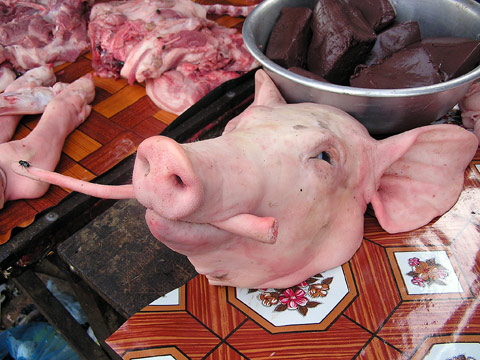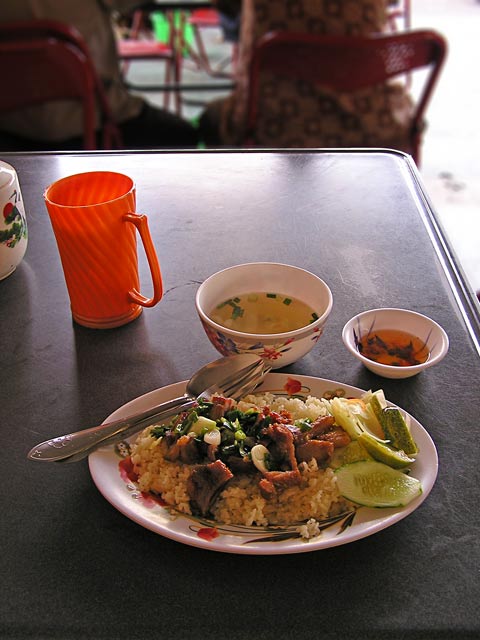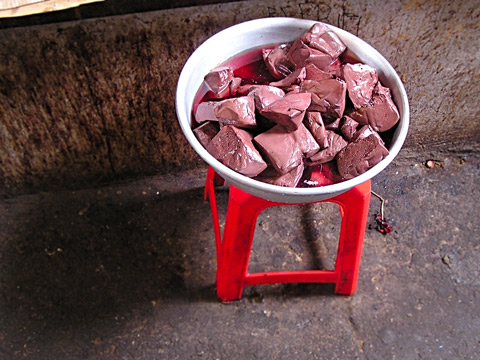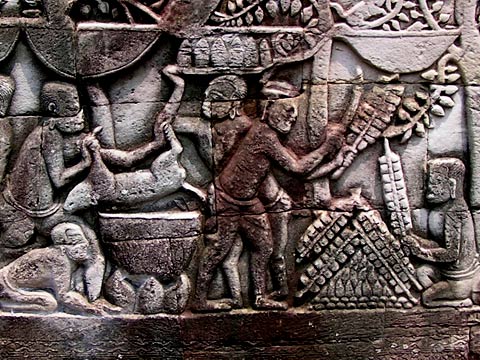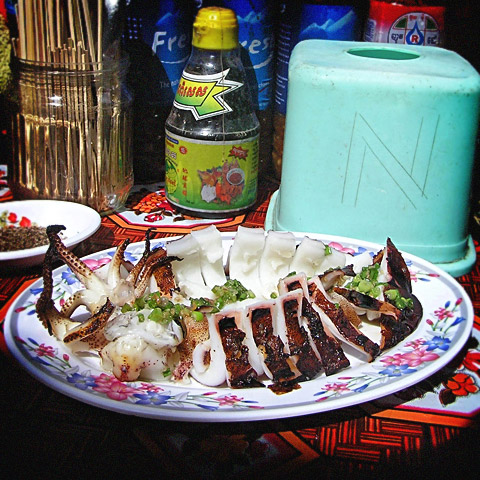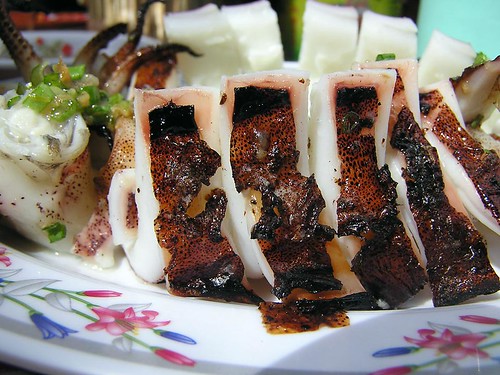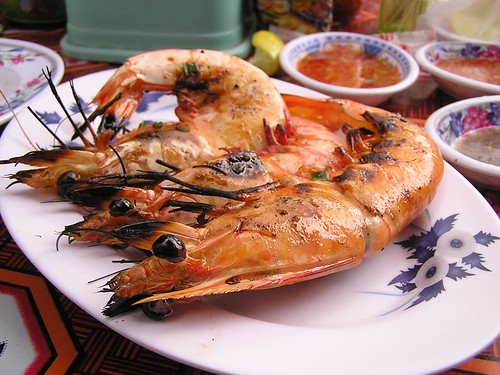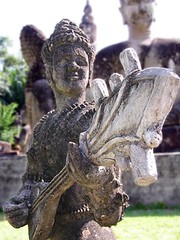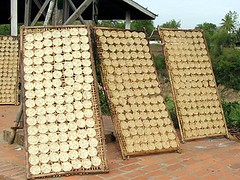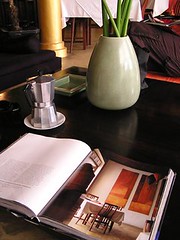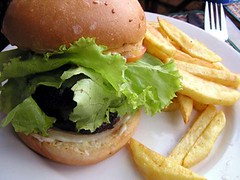A butcher’s dark sense of humour at Psar Loeu, Siem Reap.
Category: Meatporn
Pork and Rice: The national breakfast.
There are four types of Cambodian breakfast: pork and rice (bai sach chrouk); noodles (mee cha) or noodle soup (khtieau); rice porridge (bobor); and the improvised foods of those who are starving and eat whatever they or the World Food Programme can unearth. At a rough guess, these groups equally split the population (with an outcast minority such as me who tend to only eat breakfast on weekends and therefore try to make it as decadent and calorific as humanly possible. In the view of most Cambodians, my diet is not so much unbalanced as it is unhinged; and thus somewhere outside orthodox classification).
The standard Cambodian pork and rice set is as follows: any boneless cut of pork, thinly sliced and barbecued on a wire grill over warm coals then served with a hefty plate of broken (or just cheap) rice. The pork is sometimes marinated in garlic and oil, but more often than not, is just cooked slowly over the fire to soak up the fat-induced smoke. The side is invariably pickles, most commonly cucumber. The below pickles were a piquant mix of fresh ginger, cucumber with still a hint of crispness and paper-thin slices of daikon radish.
The set will include a bowl of thin chicken stock from the noodle soup master stock, topped with spring onions, and a dipping bowl of sweet chilli sauce (tuk mteis). The method of eating the stock is to either eat it uncut or take a small spoonful of rice and then top up your spoon with a little stock. The above chilli was blindingly hot which is a real rarity, because the sweetness tends to outweigh the capsaicin.
If cutlery is not already present on the table, then it will arrive in cup full of steaming and sterilising water (orange and plastic, above) and the correct etiquette is to wipe down your knife and fork with a provided napkin or toilet paper, disposing of the paper on the floor or into a provided tableside bin. Do not under any circumstance drink the water in the sterilising cup.
The eateries are at their busiest from 6:00am until 8:00am, as most locals have seemingly been up since sunrise and need a huge carb-and-lard boost to get them through to the interminable hours until the midday meal. When busy, all tables are considered communal. It is perfectly acceptable to intrude on anybody’s table and engage them in your wittiest repartee. My Khmer wit is extraordinarily limited, although everyone gets a laugh out of how I can’t properly pronounce the word for ‘glass’. Unlike Vietnam or Thailand where small breakfast vendors often lack tables, a Cambodian pork and rice vendor without seating and a rudimentary bench is an exception. Where the tables are not built from the thin metal, they are covered with a garish vinyl tablecloth which is either geometrically patterned or provided as an advertisement from a large soup or monosodium glutamate manufacturer.
By 9:00am, breakfast will be over. Small pork and rice joints will disappear entirely to be replaced by lunchtime soup, fish and rice vendors. Brunch is not an option.
Location: Pictured pork is from my coffee roasting friends at the corner of Street 432 and 155, but there is a pork-charring crew on practically every Phnom Penh side street in the mornings. The best guide to picking a great bai sach chrouk vendor is finding one where the barbecue is still smoking and pork is served directly from the grill to your plate. Most vendors buy their pork daily (as a cashflow issue rather than not having proper storage) and so freshness is guaranteed.
Continue reading Pork and Rice: The national breakfast.
Pig’s Blood Tofu
In keeping with this week’s theme of ‘Surprise, it has PORK in it!’ these innocuous tofu-like chunks are congealed pig’s blood. Cambodia is one of many nations to embrace eating every part of an animal that is humanly possible, and with pigs, this means every part from snout to asshole.
Unlike snout or asshole, the blood tofu tastes more neutral and spongy, and is used as an addition to soups or noodles with broth. As the blood tofu ages, it tends to turn from congealed red to slightly grey. If you were unfamiliar with it, you would probably push a small cube of it to the side of your bowl after a nibble, along with the other chunks that fall into the ‘mystery innard (not pipe-shaped)’ category, still unsure if it comes from an animal or not. When in doubt, it’s always a pig part.
Celebrating 1000 years of scandalous Cambodian meatporn
Rule One: Don’t eat sashimi in the desert
If I was writing a rulebook on Third World roadside eating, at the top of my list would be “Don’t eat seafood unless you can see the water from whence it came”, which I could probably shorten to something snappier and memorable like “Don’t eat sashimi in the desert”. Despite my wariness towards Third World streetside seafood, when I spot a vendor who is keeping their raw produce on ice, it pays to give them the benefit of the doubt and break a few cardinal food rules. This mom-and-pop kraken charring duo were keeping their squid-on-a-stick iced in a plastic bucket at the entrance to Phnom Penh’s Central Market.
Compared to the diminutive beachside-in-Sihanoukville variety, this squid looked like it would play a starring role in the delirious undersea nightmares of Captain Nemo. Served charred, sliced into bite-sized pieces and topped with a spoonful of spring onions and fish sauce.
Barbecued prawns (bawngkia aing) are also on the largish side, basted with the same sauce and onion mix. Sides of fresh but sickly sweet homemade chilli sauce, salt/pepper/lime juice dipping sauce, and a green tomato, chee krassang and cucumber salad were complementary. At 32000 riel (US$8(!)) for two plates of giant squid and a plate of prawns, these snacks are premium priced but top hole.
Location: The main eastern entrance of Central Market, Phnom Penh, after 2pm. Central Market (Psar Thmei) has a changeover period at about 2pm when the “official” food vendors who dwell near the northeastern wing in tiled concrete booths shut up shop completely, and a few makeshift stands open at the main eastern entrance to the market, serving late afternoon/dinner snacks.
Laos Food Bonanza
When my commentary on Khmer food slows down, I’m usually out of Cambodia and this time it was in the only Indochinese country described as sleepier than Cambodia: Lao PDR. Thanks to having some friends in Vientiane, I did get to eat a fairly representative sample of the local delicacies.
Sticky rice (kao neaw) is both self explanatory and ubiquitous as the national staple. The process to make it seems complex enough that it involves a fire, a purpose-built basket and constant attention; akin to the early years of ballooning but with slightly less chance of setting yourself on fire and crashing back to earth in a ball of fiery death. It might give the rice a stickier and more fibrous texture, but I think that I would rarely have the time on my hands that it takes to prepare.
In more proof that if you can grind up an animal, you can eat it, laap, the ever-popular minced meat salad, is available in every imaginable meat. I managed to fit in laap in five different ground animal flavours but none in the evil non-meat equivalent, tofu laap. Whenever I attempt to build myself some laap, I can never balance the chili/lime/galangal/fish sauce properly, and so every Laotian laap I ate fills me with both shame and meaty deliciousness. I heard tales of iguana laap but had no success in finding a local lizard grinder or procuring myself an iguana. The local Laos green papaya salad (Tam Mak Hung) is spicier than our Khmer variety and there also seems to be a marked preference to go a little crazy on the fish sauce.
For me, the two main drawcards of Luang Prabang seemed to be the town’s World Heritage listing and a regionally famous snack made from dried sheets of river algae that comes with a buffalo rind and chili sambal.
From the early part of the dry season, northern Laotians harvest river algae (kai) that they then proceed to sun-dry before pressing into flat sheets with sesame seeds and local vegies. The resulting algae paper (kaipen) tastes like the kelp wrapping from a sushi roll, deep-fried; and the traditional accompanying paste made from ground chili and buffalo rind tasted much like someone had set a fistful of large, sliced rubberbands alight in my mouth with roughly the same texture. Before coming to Laos, I was told that it was “a great snack to eat with Beer Lao” which I should have translated as “a great snack to eat when incomprehensibly drunk”. The buffalo isn’t all bad, as Laotians also make an excellent buffalo sausage.
As for restaurants:
Moon The Night – Not a suggestion for an lewd gesture aimed at the evening but a local restaurant overlooking the Mekong, upstream from the main strip. Like every good local Indochinese restaurant, it blares local pop music at earbleed levels. Their duck laap was excellent although padded out with various offal. Not that there is anything wrong with that.
The strip of local restaurants that line the Mekong roughly opposite the Lane Xang Hotel seem to vary in quality with the weather, but are good for a cheap sticky rice and laap fix.
My brother, who worked in Laos for a while recommended me…
KhuVieng Fried Chicked (KFC). If this doesn’t make a phnomenon write-up, the universe is in a state of imbalance. The crispiness of the chicken puts the Colonel to shame, yet the establishment is somehow notably absent from my edition of the LP. It’s near a large tree about three-quarters of the way down Khu Vieng street if you’re heading towards the Australia Club. It’s on the right and easy to miss, so take your time.
…but I couldn’t find it in several very slow passes on my hired Suzuki Viva. However, just off Khu Vieng is a great spring roll store aptly named The Spring Roll Store. Their spring rolls aren’t bad but the mystery rice salad that accompanies the rolls is excellent. There are two ingredients in it that I can’t identify and I’ll mail a can of your choice of Klang to anyone who can speak enough Laotian to find out. If you’re in Phnom Penh, I’ll drop it by your house in person. One of the components is deep-fried (a spring roll part? Deep-fried leftovers?) and the other is a vegetable (Green papaya? Mango? Cucumber?).
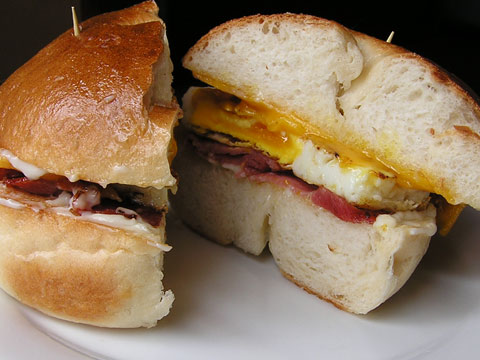
JoMa Café – So barang that it physically hurts but that didn’t stop me from visiting both the Vientiane and Luang Prabang outlet for Bagel Eggers (17000 kip, above; no relation to David) and good espresso with choice of local or imported beans. I’m on holiday. Your Cambodian breakfast bobor is no match for the true might of a bacon sarnie and decent coffee. Location: On Sethathirath Road in VT; Near cnr of Sisavangvong Rd and Setthatihilat Rd in LP

Luang Prabang Night Market – At the end of the night market (opposite the daytime Handicraft Market), a small alleyway becomes a Laotian street food emporium. Despite being on the way to dinner elsewhere, I did my best to pick up a selection of deep-fried things (a few balls of deep-fried sticky rice coating a nugget of banana, 5000kip for a hefty bagful; spring rolls, 2000kip worth) to eat en route. There were some good sized racks of pork that I would have had a crack at, but thought it might offend my fellow diners if I rocked up with half a side of a pig.
The Apsara – Herbert Ypma’s Hip Hotels calls this place “the most chic hotel in Luang Prabang” which I only know because they had two different copies of Ypma’s trendspotting tome displayed on their coffee table. Seems to be the only modern place in town that recognises Luang Prabang’s period of suzerainty under Jayavaraman VII, at least in name although no Cambodian food from that era on their “Asian fusion” menu. Their $6 steak frites (below) was a cheap, unidentifiable cut but at that price I would be happy to gnaw on a another strip of buffalo. I take my iron where I can get it. Location: Ban Wat Sene, Thanon Kingkitsarath, Luang Prabang.
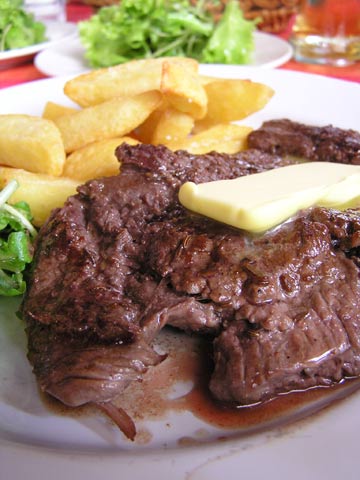
Are there any Laos food blogs out there? Comments are open.
Seeing how the other half lives – Malis and Pacharan
I’ve had an excellent weekend of eating because I’ve had a friend in town who was up for an Ibero-Khmer food mashup and acting as an excuse to eat out for every meal.
Previously I’ve avoided Mali’s because of the large number of Black Landcruisers out the front. I’m convinced that if the ratio of Black to White Landcruisers is wrong, either the food is bad, expensive and over-Westernised (too many White) or the venue is actually a karaoke brothel (too many Black). Mali’s is in fact, neither. Khmer purists will inevitably point out that the food is both Westernised (i.e. the delicious Pumpkin Brulee; the general presentation; the lack of bones or napkins dropped on the floor) and under the fickle influence of Thailand (‘Ack! Lime leaves!’), but I’m a strong believer that absolute authenticity is for chumps. Eating in air-conditioned comfort during the hot season is a godsend.
You know that you are really settling into Phnom Penh when faux-Angkorean statues have the inability to look anything but cheesy and you have hot season fever dreams wherein you are chased by people with stone Jayavaraman heads or Rama’s deadly monkey army.The cheesiness at Mali’s is toned down a notch but I still can’t help but cringe at neon-lit Leper King statue at the entrance. It isn’t to my personal taste but as Edward Said sez ‘Since the time of Homer every European, in what he could say about the Orient, was a racist, an imperialist, and almost totally ethnocentric’. Bring it on.
Unable to cope with the postcolonial landscaping dissonance, we ascended the cantilever stairs into air-conditioned comfort. Our attentive, besuited waiter was particularly keen to pimp a langoustine tamarind-sour soup upon us, with which we had no truck. We opted for a round of cocktails while we perused the photo-rich menu.
After much discussion of the campness of the Side Car versus the Long Island Ice Tea as metonym for suburban housewife alcoholism, we agreed upon entrées of the small ‘natural scallops’ in rich glutinous sauce ($4.90) and the extra chunky prawn cakes ($4.90). Despite our waiter’s samla fetish, for mains, we shared one gigantic King Crab ‘fresh from Kep’ ($9.20) with my current favorite local ingredient: fresh green Kampot pepper; stuffed pork fillet ($4.80); and a falling-off-the-bone duck curry with a yellow kroueng sauce ($5.10) rounded out our five meat meal. We washed it down with a bottle of the reasonably priced Marsanne ($16).
There’s no denying that this is the most expensive Cambodian food that I’ve eaten in Phnom Penh, if not the most expensive Cambodian food available. I’m well past feeling guilty about eating a meal that adds up to the same amount as a coworkers monthly salary. If you’re keen to show that upscale Khmer food can fit into the Western paradigm of good food, Mali’s is probably the place to coax your foreign visitor, before you head downmarket.
Overall, I award the experience two Leper King arms and one Landcruiser out of a possible two.
Location: Just south of the Independence Monument on Norodom Boulevard. Yellow Pages.
I can’t believe it’s not patxaran
Pacharan is still Phnom Penh’s most talked about venue, if only because of the impact of walking up the stairs into the second-floor restaurant and feeling that ‘I can’t believe I’m in Cambodia’ sensation warm you like a glass of sloe and aniseed liquor. Its immaculate timber fitout, hammered copper features, custom artwork and stained glass in orange and yellow hues lend the stairwell and room a real warmth and depth of character that most Phnom Penh eateries sadly lack. It certainly isn’t like your average Spanish tapas bar but it is the only one with a view of fisherfolk floating down the Tonle Sap.
I’m glad we booked a table because by 8:00pm the room was packed and loud, with patrons being seated at the bar in wait. It is a strange sight to see waitstaff moving efficiently and at speed in Cambodia, but both were happening as the frantic open kitchen churned out Spanish morsels.
Service was not only quick but impeccable. Our thin wafers of manchego cheese, cheese-stuffed eggplant, albondigas, both the chicken and vegetable croquettes (all around $4 each) arrived within 10 minutes of our order; and our second jug of Sangria ($11) was refilled practically without needing to ask.
The big surprise for me was being served some rocket as a garnish. Rocket self-seeded in my tiny garden patch in Australia and grew at a rate that even the most maddened pesto fiend couldn’t pulverise it into a tasty pulp, before it outstripped my entire backyard. It not only had the ability to grow between the cracks in the pavement but could also materialise from the aether fully-formed. If I hadn’t left the country I believe that it would have achieved sentience and triffid-like defences by now. I realised that I had not tasted a single sprig of the peppery green since I left Australia more than a year ago and now it has returned to overrun Cambodge.
Pacharan might be the first tapas bar in Phnom Penh, but it certainly won’t be the last judging by the response from nearby businesses. K-West is holding a Spanish Week this week and Sa, next door to the Pacharan entrance, has already added tapas to the menu. Misguided stupidity is the sincerest form of flattery. I’m hoping that we’ll also be seeing a new era of Ibero-Khmer crossover: num anksom with Iberian ham, kroeung paella, prahok-stuffed olives and palm wine sangria.
Location: Corner Sisowath Quay and St.184. Enter on St.184. Yellow Pages.
Phnom Penh Hamburger Fiesta
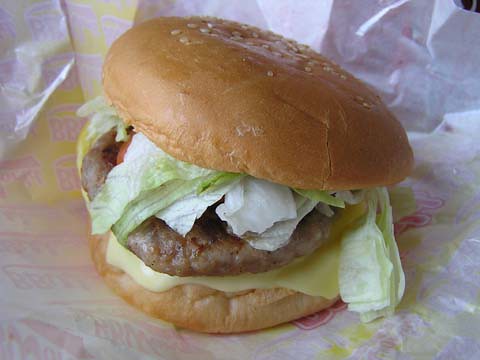
Regardless of how committed you are to eating Khmer food, about a week in, you will crack, eat hamburgers, and then have the nerve to complain about the blandness of Khmer food. Then you’ll see the error of your ways and the circle of life will continue, unhindered. I’ve selected a random assortment of places that serve hamburger because anyone with a charcoal burner and the ability to grind up animal components has it on the menu.
With the unsubstantiated rumour that McDonalds is doing some poking around in the Cambodian market, I thought I’d do a quick round-up of the Phnom Penh burger scene before the international competitors can begin on the path to domination. To make a bold statement, I’m willing to bet that both a Burger King (whose Thai franchise is run by the same crew that own The Pizza Company) and a McDonald’s will be open in Cambodia by year’s end. Lazy travel writers will no longer be able to use the thesis that Cambodia is still unspoiled by global culture because there are no Western fast food outlets.
Lucky Burger
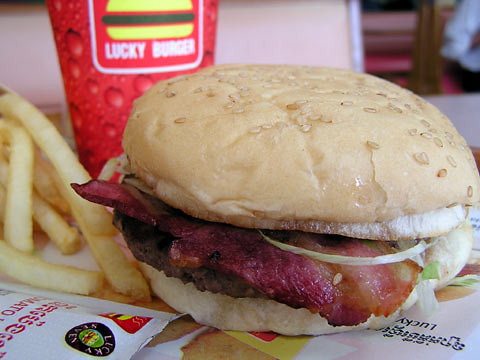
The scary thing about global capitalism is that it reveals that everyone in the world actually wants the same McDonalds hamburger. People put their local spin on it depending on the dictates of national culture (e.g. Ramadan happy meals, Hindu lamb burgers) but ultimately everyone actually wants to eat the same thing. There is something about frying beef fat that bypasses culture and hits people in their reptilian brainstem. Maybe when the asteroid hit the surviving animals were the ones with a predilection for their charred mammalian comrades. As no Maccas nor asteroid has arrived in this neck of Indochina yet, Lucky Burger is the next best (and slightly less apocalyptic) thing.
I had their Lucky Bacon Burger Set which came with a side of fries and a Coca-Cola ($2.70). The burger patty was thin and uniformly circular, accompanied by bacon, shredded iceberg lettuce, raw onion, “special” sauce and a very lonely slice of pickle. Tantamount to a McSomething? I have no idea. I tend to only eat at McDonald’s when I’m trapped in an airport and the only other culinary option is washing down a gigantic duty-free Toblerone with an equally gigantic bottle of Tanqueray.
Location: Sihanouk Boulevard, above Lucky Supermarket, near the corner of Monivong; at the Mao Tse Toung entrance of Parkway mall; and on the corner of Monivong and St. 217 near Psar Thmei.
BB World
As a testament to the lack of imagination when it comes to design, BB World’s previous logo was an inverted McDonald’s “M”, which they used as the “W” in World. You can still see an example of it on the menu above the counter, hidden slyly on the cups of cola. I’d love to know how McDonalds got to them because it seems like the only act of piracy in Cambodia that has been cleaned up in preparation for the 2013 accession to the WTO copyright provisions. The logo has now transmuted into BB Man, primary-colored defender of wholesome Khmer burger goodness, in preparation to kick that thieving Hamburglar’s ass.
I had originally planned to rig up a double blind taste test with Lucky Burger to see if they were essentially the same product, but I’m not really up to eating more than one of those burgers a day. For a change of meats, I ordered the porcine BB Cambodia Burger Set with extra cheese and an egg, side of fries and a Coke ($2.90).
As far as I could tell, the burger was indistinguishable from Lucky’s burger with the exception that the BB Cambodia burger has a pork patty rather than the traditional beef. With a mushy bun, all elements of the burger had an undifferentiated consistency, apart from the iceberg lettuce. The bonus egg was more like an omelette and a mistake on my part. Fries were well-fried to a pleasing dark brown and their box assured me that they were fried in nought but vegetable oil.
It still sits like a ball of lead in my stomach.
Location: 2nd floor of the Sorya mall; and on Sihanouk, near the corner of Monivong. The Sihanouk store has a giant model hamburger on the roof which I bet has the same nutritional content as their burgers.
California 2
I only ended up here because faux-english bar, Rising Sun, was closed and I had it set in my mind that today was the day I’d give Khmer food the middle finger and review burgers. I had the double cheeseburger ($2.75) and a side of thick cut fries($1). I was greeted with two small hard pucks of beef, cheese, mayo, tomato and lettuce on a sickly sweet bun. To its credit, those pucks were beefy.
Location: #317 Sisowath, near the corner of 148
Steve’s Steakhouse
There is something in me that wonders if the Steve from Steve’s Steakhouse and Steve from Steve Water are the same man. If so, I commend his entrepreneurial spirit and his Eulerian ability to name things after himself. I went for the Big Hamburger with a side of fries ($3.49 + service charge). It had certainly the biggest patty of fresh, juicy beef I’ve seen; a slightly sweet bun, Asian lettuce, tomato and raw onion. Steve’s serves condiments on the side: so you can run the gamut of HP Sauce, “Classic Yellow” mustard, tomato sauce, and probably prahok if the Imp of the Perverse had taken your senses for a joyride. You can literally order burger by the pound here, and while my heart says “yes”, my colon says “no”.
Next time I need an iron fix, I’ll head back to Steve’s and do his Argentinian steak some justice with a real review.
Location: Corner of st. 51 and St. 282
Roadside Burger Stand on st.432
The last hamburger I ate from a roadside stand was in San Jose del Cabo in Baja California and I only ate it because had already eaten the last of their delicious chili clam tostadas and had a belly full of cheap Ballena lager that yelled “cowflesh”. This one plies its greasy wares at the Toul Tom Poung school gate, letting kids experience the epiphany of Western grease at an early age.
They must run a roaring trade in breakfast burgers because each time that I’ve stopped in for a burger at midday, they’ve already sold all their meat. Lack of refrigeration be damned. Sadly, they were fresh out of beef this morning, so I had to content myself with a breakfast of well-cooked porkburger (2500riel) which was served with a squirt of mustard and chili sauce on a sweet bun. What it lacked in vegetables, it made up for in hog fat which the bun did a fairly poor job of soaking up.
Location: St. 432, near the corner of St.155
Other burgers of note:
Songtra Icecream and Hamburger
Somebody hooked me on Songtra’s sundaes about a week after I arrived in Cambodia and I’m still going back for their chocolate and coconut icecream. Like their general ambiance, the burgers are sloppy and cheap.
LocationOpposite the Phnom Penh Center, on Sisowath near the corner of. There is another restaurant of the same name further north on Sisowath.
Big Hamburger
Part of the licensing process of opening a Western-style supermarket in Cambodia obviously involves a certification of your ability to serve a hamburger. As such, Big A Supermarket has followed Lucky’s lead and opened its own chain-style burger joint next to its supermarket on Monivong. I have no idea what the burgers are like and have only been into Big A on the strength of a rumour that they stock home brew kits at the same frequency that both Sam Rainsy and King Sihanouk are in town. I’m willing to bet a case of Anchor that the Big A burgers are exactly the same as Lucky or BB World.
Location: At the corner of Monivong and St.178 (?)
Sharky’s
A friend recommended their burgers, but I’ve had enough of eating grease to make it there. If the burgers are as good as the rest of their Tex-mex bar food then they’re definitely worth a try, as long as you don’t mind the sex worker atmosphere.
Location:Street 130 between Street 15 and 19.
Got a favourite Cambodian burger joint amongst the hundred or so that I’ve missed? Comments are open.
Addendum (15 February 2006): McDonald’s replied to my email questioning their motives in Cambodia with this fairly vague response and the criteria with which you could own the first Cambodian McDonalds outlet.
Thank you for your inquiry regarding a McDonald’s franchise in Cambodia. McDonald’s intends to develop restaurants in Cambodia, however, a firm date has not been established for this development.
When we proceed with plans for the development of restaurants in Cambodia, our primary franchise candidates for a McDonald’s franchise will be individuals who possess the following basic requirements: (1) high integrity; (2) business experience in the market; (3) knowledge of culture and customs of the market; (4) willingness to devote full time and best efforts to the McDonald’s venture; (5) willingness to train in another country for approximately nine months (6) knowledge of the real estate market and management experience; and (7) ability to work well within a franchised organization.
Additionally, candidates must possess the capital necessary to invest in the venture. Since international franchising structures and methods can vary greatly, financial requirements cannot be ascertained.
If you meet the basic requirements set forth above, please complete the attached questionnaire and return it to us. We will summarize and catalogue the information and when we move forward with our development plans, we will contact you if we wish to proceed with you as a franchisee.
Thank you for your expressed interest in McDonald’s Corporation.
Meatporn to go on st 432
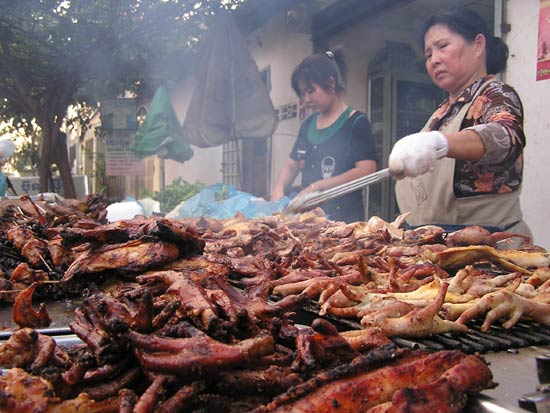
At about 5:00pm every day, the intersection of street 432 and 163 jams up with both traffic and the smell of barbecuing flesh. This stand does chickens: whole, pieces, heads, feet, and heart or liver kebabs; a few fatty barbecue cuts of pork; and whole quail thrown in for good measure. All grilled over the hot coals and dished up steaming hot into a polystyrene clamshell.

I wasn’t in the mood for fowl, so I went for a short rack of pork ribs, beautifully caramelised; served with a take-away pack of limes, salt, pepper, weak chili sauce, Vietnamese coriander (chee krassang tomhom(?)) and a stubby cucumber (3000r). There’s not even the vainest attempt at having seats: so get your meat and try and negotiate a path through the traffic home before your food congeals.
Location: Corner of street 432 and 163, close to Russian Market. You’ll see the smoke signal from about 3pm weekdays and keeps charring until the flesh is sold.
